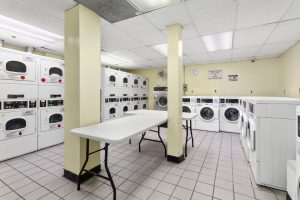Talk about finds on the Upper West Side: Twenty- four years ago, Tiga McLoyd, Real Estate entrepreneur and a broker with Corcoran, took chance by the horns. His risk materialized as gold in the form of a 900 sq. one-bedroom apartment with a view at the Lincoln Spencer at 140 West 69th Street. He’s been living there for more than two decades and can’t even imagine moving. Among other things, he described the location as the best in the world and only “a song’s commute” to his office at 67th and Columbus Avenue (157 Columbus Avenue).
The Spencer Arms (now Lincoln Spencer Co-op,) was built in 1903 as a luxe residential hotel. The 12-story building had hugely deteriorated and was in declining financial turmoil when Tiga first learned the building’s sponsors were auctioning their apartments.
Having recently graduated from the University of Michigan, he had been working at Citibank. Although he was interested in real estate, he had little money to invest. A woman he met was overseeing the auctions of apartments on the Upper West Side that were going for $50,000, $60,000, and $75,000. She sympathized with his situation and alerted him to an opportunity when it came up. The price was $12,500. The conditions were that existing tenants were allowed to continue living in their homes until they vacated.
Another condition was that the apartments be purchased sight-unseen, and the terms also required that Tiga pay for maid and switchboard services (which are part of the existing tenants’ contract from the period when the building was a residential hotel). Tiga was able to bypass the sight-unseen issue by arranging a meeting with the tenants. He told them that as a prospective purchaser of their unit, he wanted to ensure continuity of the hotel services – which also allowed him to have a look at the apartment. He contacted the tenant and her husband, acclaimed French cellist Marcel Hubert. Mrs. Hubert confided that after her elderly husband passed away, her plan was to move back to her native Vienna, Austria.
Only a year later, Tiga moved in. He created an entirely contemporary environment. Among other features, he is pleased with the addition of an electric fireplace that not only looks real but also has a heating element, producing extra coziness on cold winter nights.
 The building has been renovated over time. Services once provided by in-house uniformed maids and laundresses who lived in small rooms on the upper floors and the switchboard operators are long gone. But, the central laundry room in the basement remains – though much enlarged and refurbished with contemporary laundering equipment.
The building has been renovated over time. Services once provided by in-house uniformed maids and laundresses who lived in small rooms on the upper floors and the switchboard operators are long gone. But, the central laundry room in the basement remains – though much enlarged and refurbished with contemporary laundering equipment.
Periodically, water tanks on the roof are replaced. They provide residential buildings like the Lincoln Spencer with a water supply and are essential in the delivery of tap water and water used in laundering. Water tanks today are not much different from the originals, but current laundry room equipment is different compared with what it was in the early 20th Century.
Vintage equipment photographed in some other UWS buildings of the period shows that domestic servants typically used equipment that did not depend on electricity. Besides large wash basin sinks for soaking, before the mid-1930s and the growing popularity of domestic electric automatic washing machines, early gas-operated washing machines were fitted with hand-cranked wringers to squeeze out excess water from the wash. Drying was usually accomplished using panels that pulled out from a cabinet. The panels were fitted with tube-like gas-heated drying racks. Sheets were ironed, and trousers and shirts pressed on a threatening-looking device called a mangle that often broke mother-of-pearl shirt buttons but could produce smooth sheets and sharp creases on trousers.
Domestic servants in residential hotels, like homemakers, may well have been influenced by laundry rituals that went back at least a century. According to Medium.com, “Monday as washday is a very old tradition, based on pure practicality. Before the automatic washing machines, doing laundry was an all-day task. Then drying and ironing might take most of the week (depending on the climate), and the whole thing had to be out of the way by Sunday, the official day of rest.”
With some exceptions, apartment building laundry rooms were tiled and dark, located in basements. Today, the central laundry room at Lincoln Arms is brightly lit. Electric washers and dryers are electronically programmed and set in motion with cards.
If Tiga seems familiar to you, it may be because he and Broccoli, his 12-year-old rescue dog, were discovered in front of Magnolia Bakery on Columbus Avenue and featured in the Humans of New York blog. Tiga got over a million likes.
Board member Brian Shait is a professional designer and contractor who, around 20 years ago, designed and provided oversight for the most recent renovation of the building’s impressive hallways and lobby. Asked about artifacts of the past, he said he has never used the laundry room as he relied on neighborhood wash-and-fold services.
However, many years ago, as a new board member, he was charged with making sense for fellow residents of the city and building policies regulating installations of in-apartment washers and dryers. This is a convenience he now relies upon in his own apartment.
Also, Brian was personally involved with the answer to what to do with the old, switchboard communications technology at the front desk of the lobby. Brian and the rest of the Board agreed to have it covered up, producing a multileveled desk recalling a courtroom bench. The oddly shaped desk was something of a building joke at the time it was first constructed; insiders were heard to call out to each other, “All rise” on entering the building as if the court was being called into session.
Resident Superintendent Willie Garcia is proud of the consistent maintenance of the building’s two water towers, which are cleaned annually. One tank is used for storage of water for daily use by residents. The other is filled with water and maintained in the event of a fire.
Willie has worked in the building for 30 years. When he first arrived at 140 West 69th Street, as now, the laundry was managed by an outside company. “The biggest difference was that the machines were coin-operated. This was the early 1990s. It [only] cost 50 cents to wash a load of laundry,” he said.

 By
By